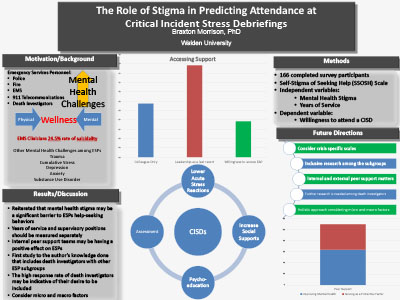ABSTRACTS
The Role of Stigma in Predicting Attendance at Critical Incident Stress DebriefingsAuthor: Braxton Morrison, Gregory Hickman, and Ann Morgan | | Associate Authors:
Emergency services personnel (ESP) have been found to have increasing numbers of behavioral health conditions and suicidality due to the traumatic stress they endure in the line of duty. Despite widespread efforts to combat and reduce mental health stigma, rates remain elevated, and responders continue to suffer and lose their lives to suicide. Critical incident stress debriefings (CISDs) are one form of crisis intervention designed initially for ESP to mitigate and normalize acute posttraumatic reactions while building unit cohesion. Objective: To examine how the presence of stigma among ESP (law enforcement officers, firefighters, EMS clinicians, 9-1-1 telecommunicators, and medicolegal death investigators) and the number of years spent in emergency services predict attendance at CISDs. Methods: A quantitative, cross-sectional study was performed. The study was viewed through the theoretical lens of Richmond’s person-in-environment theory due to its holistic and inclusive foundation. The research question for this study was to examine to what extent stigma and years of service among ESPs could predict attendance at CISDs. Results: The results of the study were not statistically significant: χ2 (3, n = 171) = 1.594, p > .001, meaning years of service, when coupled with stigma, did not predict attendance at CISDs. Conclusion: Future research may consider gender as a variable to study, as over 60% of participants were female. Furthermore, ethnicity and age are recommendations for future research, as many variables may impact attendance when coupled with stigma. Various social change implications may arise from this study, such as researching new variables affecting stigma, as well as impacting crisis organizations' research and interventions for ESPs in the United States.
|

